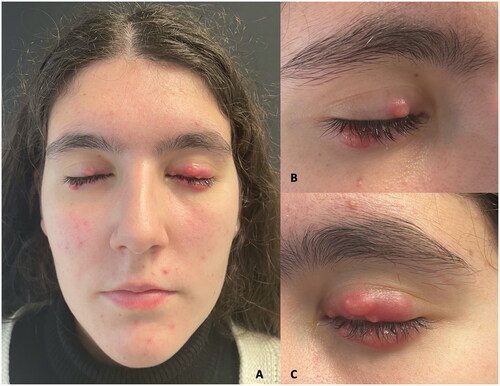Dear Editor,
We would like to congratulate the authors, Samed Magdy Sarsyk and Heba Saed El-Amawy on a thorough literature review [Citation1] that shows not only a comprehensive understanding of dermatological therapies but also the willingness to explore unorthodox alternatives overlapping other tangential areas of Medicine. This review shows a refreshing and systematized approach to some uncommon therapies, since eye drops are not among the usual dermatological arsenal. Admittedly, we ourselves frequently rely on such therapies and therefore we would like to present a recent case of a 16-year-old woman who was referred to our Department due to moderate-severe ocular granulomatous rosacea that has been successfully treated with cyclosporine eye drops despite their alleged low quality evidence [Citation2,Citation3].
According to the authors, eye drops have proved to be not only easily available, economically efficient and well tolerated by patients, but furthermore they might obtain a surprisingly effective outcome in ordinary pathologies (such as cutaneous angiomas, acne and rosacea, some variants of alopecia, and so on); even when many of the first line dermatological remedies do not manage to achieve improvement. As a consequence, it has been suggested that some of these remedies might be under-used in our daily practice [Citation1]. Cyclosporine is a calcineurin inhibitor immunosuppressor frequently used in ophthalmology [Citation4] for treating a variety of conditions like autoinmmune kerathopathies (such as peripheral ulcerative keratitis ‘PUK’), atopic keratoconjunctivitis, dry eye syndrome, blepharitis, corneal transplant rejection… Despite some authors have already showed interest in using this ophthalmic emulsion for dermatological purposes [Citation5], it was not included in the revision.
The clinical picture of our patient included typical signs such as facial redness, papules, pustules and a history of repeated episodes of flushing. Besides that, since 6 months earlier, granulomatous lesions started to develop on her eyelids (), leading to the avoidance of social events and impairing the patient’s quality of life. She had carried out 84 days of treatment with doxycycline 100 mg daily without clinical improvement. We prescribed isotretinoin 20 mg a day and a topical cleansing-moisturizing routine based on glycerin, niacinamide, and hyaluronic acid. After more than 2 months of treatment with no visible response, we added cyclosporine 0.05% eye drops once a day, leading to major improvement and resolution within 5 months with no adverse effects (). The patient was followed up for 3 months without relapses and was eventually discharged.
Figure 1. Clinical picture of the patient pretreatment. (A) Face overview with papules, pustules, redness, and periocular granulomatous rosacea involvement. (B) Close view of the right eye. (C) Close view of the left eye.

Figure 2. Clinical picture after treatment. (A) Face overview with less papules and pustules. (B) Close view of the right eye. (C) Close view of the left eye.

Rosacea is a common, chronic, inflammatory facial dermatosis that can heavily impact our patients’ quality of life. Its pathophysiology is not fully understood, yet both genetic and environmental factors (including the dysregulation of the immune system, neurovascular dysfunction and the presence of Demodex folliculorum) play a role. Ocular involvement in this chronic condition is estimated to occur in approximately 75% of patients, symptoms ranging from dryness and foreign-body sensation to eye lids skin lesions [Citation3]. General measures for rosacea, as well as a proper hygiene and on demand use of artificial tears are of the essence for the treatment of ocular involvement. However, we often need to add pharmacological treatment in order to control the disease.
Some systemic therapies like isotretinoin and doxycicline have proved to be benefitial for different rosacea subtypes. Topical approaches can also be as effective, and account for less adverse effects. In our case, given the age of the patient, the severity, and the lack of improvement after 5 months of systemic therapy, we draw upon cyclosporine emulsion as there was no active ocular infection in order to deliver quick relief [Citation2]. Other alternatives that have been suggested include fusidic acid gel and 0.75% metronidazole gel [Citation3].
We hope this case might serve as a footnote to the thorough review carried out by Samed Magdy Sarsyk and Heba Saed El-Amawy [Citation1], and likewise recall the constant need to think outside the box, looking for new uses of already existing therapies, and promoting multidisciplinary approaches in order to better treat our patients.
Informed consent
Written informed consent was obtained from the patient for publication of the case details.
Disclosure statement
No potential conflict of interest was reported by the author(s).
Data availability statement
The data that support the findings are available from the corresponding author, APC, upon reasonable request.
References
- Sarsik SM, El-Amawy HS. Uses of eye drops in dermatology, literature review. J Dermatolog Treat. 2022:1–13.
- van Zuuren EJ, Fedorowicz Z, Carter B, et al. Interventions for rosacea. Cochrane Database Syst Rev. 2015;2015(4):CD003262.
- van Zuuren EJ. Rosacea. N Engl J Med. 2017;377(18):1754–1764.
- Levy O, Labbé A, Borderie V, et al. Topical cyclosporine in ophthalmology: pharmacology and clinical indications. J Fr Ophtalmol. 2016;39(3):292–307.
- Scheinfeld N. A review of deferasirox, bortezomib, dasatinib, and cyclosporine eye drops: possible uses and known side effects in cutaneous medicine. J Drugs Dermatol. 2007;6(3):352–355.

